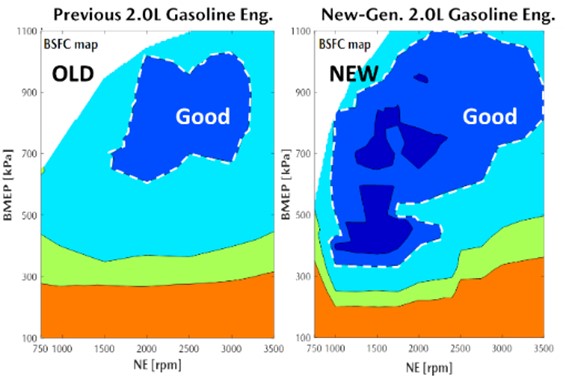Development of The New Spark Controlled Compression Ignition Gasoline Engine
1. Abstract
Continuous thermal efficiency improvement of internal combustion engine for passenger car is required to prevent global warming. In this engine development, the gasoline compression ignition combustion was adopted to realize lean/diluted combustion besides high compression ratio for thermal efficiency improvement.
The Spark Controlled Compression Ignition enabled the gasoline compression ignition combustion to be introduced in the market as the world first mass produced gasoline compression ignition engine for passenger vehicle by using original technologies.
2. Technology Contents
2.1 The aim of the engine development
The parameters which control the thermal efficiency are the compression ratio and the specific heat ratio, as shown in the theoretical equation of the Otto cycle thermal efficiency. The improvement of the specific heat ratio can be done by lean burn or by diluted burn.
2.2 Challenges in lean combustion
To obtain sufficient combustion stability under large air to fuel ratio where the NOx generation is kept low enough, the combustion needs to be completed in short period.
HCCI is known as the measure to realize rapid combustion without relying on the propagating flame. In this engine development, subjects regarding the compression ignition combustion were solved by using spark as a control measure of compression ignition. The timing of auto ignition can be controlled by the additional mixture compression as a result of propagation of spark ignited flame. (Spark Controlled Compression Ignition, SPCCI)
As shown in figure 1, in case of SPCCI, the compression ignition timing can be controlled to the target phasing under the dispersion of intake air temperature which is one of the typical disturbance of compression ignition combustion.

Fig. 1 Temperature Compensation by Spark Ignition Timing
2.3 Engine specifications and the system
To promote propagating flame speed under lean condition, high air flow intake port and combustion chamber shape were employed.(Figure 2) The high pressure fuel injection system for the ideal mixture formation, and the high response air-supply for EGR supercharging under mid to high engine load were adopted, as well as the cylinder pressure sensor for combustion sensing.
The compression ratio were set to 16.3 to 1 for European specification, and 15.0 to 1 for Japanese domestic specification respectively depending on the fuel octane number in the region.
 Fig. 2 Combustion Chamber Geometry
Fig. 2 Combustion Chamber Geometry
2.4 Engine performance
The full load torque was increased approximately 10% over the all engine speeds in comparison with the existing 2L Mazda engine, by using the combination of SPCCI and the air-supply.
Figure 3 shows comparison of the fuel consumption maps.
The fuel consumption shows large improvement especially in light load region which is often used in practical use, by the effect of SPCCI combustion.

Fig.3 Fuel consumption map (95RON)
3. Summary
The high compression ratio lean/diluted burn engine was developed. The fuel consumption shows large improvement by the effect of SPCCI combustion. The technologies used in this development will be used in future for the further improvement of thermal efficiency.
Tomonori Urushihara *1
Kouji Endou*2
Keitaro Ezumi*3
Atsushi Inoue*2
Masanari Sueoka*2
*1 JSME member, Mazda Motor Corporation Engine Performance Development Dept. 3-1, Shinchi, Fuchu-cho, Aki-gun Hiroshima 730-8670, Japan
*2 Mazda Motor Corporation Engine Performance Development Dept. 3-1, Shinchi, Fuchu-cho, Aki-gun Hiroshima 730-8670, Japan
*3 Mazda Motor Corporation PT Control System Development Dept. 3-1, Shinchi, Fuchu-cho, Aki-gun Hiroshima 730-8670, Japan